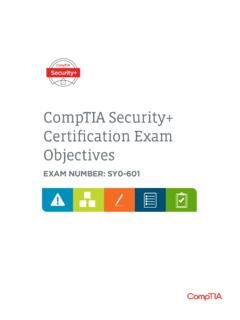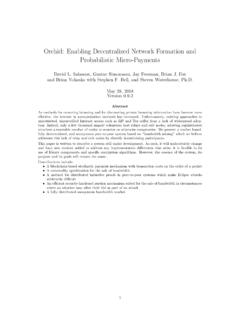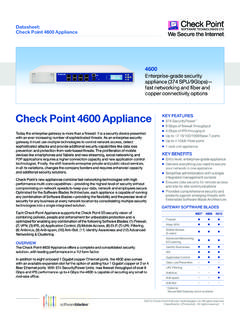Transcription of Certification Exam Objectives: N10-006 - CertBlaster
1 CompTIA Network+ Certification Exam objectives 1 of 33 Copyright 2014 by the Computing Technology Industry Association. All rights reserved. The CompTIA Network+ Certification Exam objectives are subject to change without notice. Certification Exam objectives : N10-006 INTRODUCTION The CompTIA Network+ Certification is an internationally recognized validation of the technical knowledge required of foundation-level IT network practitioners. Test Purpose: This exam will certify that the successful candidate has the knowledge and skills required to troubleshoot, configure, and manage common network wireless and wired devices, establish basic network design and connectivity, understand and maintain network documentation, identify network limitations and weaknesses, and implement network security, standards, and protocols. The candidate will have a basic understanding of emerging technologies including unified communications, mobile, cloud, and virtualization technologies.
2 CompTIA Network+ is accredited by ANSI to show compliance with the ISO 17024 Standard and, as such, undergoes regular reviews and updates to the exam objectives . It is recommended for CompTIA Network+ candidates to have the following: CompTIA A+ Certification or equivalent knowledge, though CompTIA A+ Certification is not required. Have at least 9 to 12 months of work experience in IT networking. The table below lists the domains measured by this examination and the extent to which they are represented. CompTIA Network+ exams are based on these objectives . Domain % of Examination Network architecture 22% Network operations 20% Network security 18% Troubleshooting 24% Industry standards, practices, and network theory 16% Total 100% CompTIA Network+ Certification Exam objectives 2 of 33 Copyright 2014 by the Computing Technology Industry Association. All rights reserved. The CompTIA Network+ Certification Exam objectives are subject to change without notice.
3 CompTIA Authorized Materials Use Policy CompTIA certifications , LLC is not affiliated with and does not authorize, endorse or condone utilizing any content provided by unauthorized third-party training sites, aka 'brain dumps'. Individuals who utilize such materials in preparation for any CompTIA examination will have their certifications revoked and be suspended from future testing in accordance with the CompTIA Candidate Agreement. In an effort to more clearly communicate CompTIA s exam policies on use of unauthorized study materials, CompTIA directs all Certification candidates to the CompTIA Certification Exam Policies webpage: Please review all CompTIA policies before beginning the study process for any CompTIA exam. Candidates will be required to abide by the CompTIA Candidate Agreement ( ) at the time of exam delivery. If a candidate has a question as to whether study materials are considered unauthorized (aka brain dumps), he/she should perform a search using CertGuard's engine, found here: Or verify against this list: **Note: The lists of examples provided in bulleted format below each objective are not exhaustive lists.
4 Other examples of technologies, processes or tasks pertaining to each objective may also be included on the exam although not listed or covered in this objectives document. CompTIA is constantly reviewing the content of our exams and updating test questions to be sure our exams are current and the security of the questions is protected. When necessary, we will publish updated exams based on existing exam objectives . Please know that all related exam preparation materials will still be valid. (A list of acronyms used in these objectives appears at the end of this document.) CompTIA Network+ Certification Exam objectives 3 of 33 Copyright 2014 by the Computing Technology Industry Association. All rights reserved. The CompTIA Network+ Certification Exam objectives are subject to change without notice. Network architecture Explain the functions and applications of various network devices Router Switch Multilayer switch Firewall HIDS IDS/IPS Access point (wireless/wired) Content filter Load balancer Hub Analog modem Packet shaper VPN concentrator Compare and contrast the use of networking services and applications VPN o Site to site/host to site/host to host o Protocols IPsec GRE SSL VPN PTP/PPTP TACACS/RADIUS RAS Web services Unified voice services Network controllers Install and configure the following networking services/applications DHCP o Static vs dynamic IP addressing o Reservations o Scopes o Leases o Options (DNS servers, suffixes) o IP helper/DHCP relay DNS o DNS servers o DNS records (A, MX, AAAA, CNAME, PTR) o Dynamic DNS CompTIA Network+ Certification Exam objectives 4 of 33 Copyright 2014 by the Computing Technology Industry Association.
5 All rights reserved. The CompTIA Network+ Certification Exam objectives are subject to change without notice. Proxy/reverse proxy NAT o PAT o SNAT o DNAT Port forwarding Explain the characteristics and benefits of various WAN technologies Fiber o SONET o DWDM o CWDM Frame relay Satellite Broadband cable DSL/ADSL ISDN ATM PPP/Multilink PPP MPLS GSM/CDMA o LTE/4G o HSPA+ o 3G o Edge Dialup WiMAX Metro-Ethernet Leased lines o T-1 o T-3 o E-1 o E-3 o OC3 o OC12 Circuit switch vs packet switch Install and properly terminate various cable types and connectors using appropriate tools Copper connectors o RJ-11 o RJ-45 o RJ-48C o DB-9/RS-232 o DB-25 CompTIA Network+ Certification Exam objectives 5 of 33 Copyright 2014 by the Computing Technology Industry Association. All rights reserved. The CompTIA Network+ Certification Exam objectives are subject to change without notice. o UTP coupler o BNC coupler o BNC o F-connector o 110 block o 66 block Copper cables o Shielded vs unshielded o CAT3, CAT5, CAT5e, CAT6, CAT6a o PVC vs plenum o RG-59 o RG-6 o Straight-through vs crossover vs rollover Fiber connectors o ST o SC o LC o MTRJ o FC o Fiber coupler Fiber cables o Single mode o Multimode o APC vs UPC Media converters o Single mode fiber to Ethernet o Multimode fiber to Ethernet o Fiber to coaxial o Single mode to multimode fiber Tools o Cable crimpers o Punch down tool o Wire strippers o Snips o OTDR o Cable certifier Differentiate between common network topologies Mesh o Partial o Full Bus Ring Star Hybrid CompTIA Network+ Certification Exam objectives 6 of 33 Copyright 2014 by the Computing Technology Industry Association.
6 All rights reserved. The CompTIA Network+ Certification Exam objectives are subject to change without notice. Point-to-point Point-to-multipoint Client-server Peer-to-peer Differentiate between network infrastructure implementations WAN MAN LAN WLAN o Hotspot PAN o Bluetooth o IR o NFC SCADA/ICS o ICS server o DCS/closed network o Remote terminal unit o Programmable logic controller Medianets o VTC ISDN IP/SIP Given a scenario, implement and configure the appropriate addressing schema IPv6 o Auto-configuration EUI 64 o DHCP6 o Link local o Address structure o Address compression o Tunneling 6to4, 4to6 Teredo, miredo IPv4 o Address structure o Subnetting o APIPA o Classful A, B, C, D o Classless Private vs public NAT/PAT MAC addressing Multicast CompTIA Network+ Certification Exam objectives 7 of 33 Copyright 2014 by the Computing Technology Industry Association. All rights reserved.
7 The CompTIA Network+ Certification Exam objectives are subject to change without notice. Unicast Broadcast Broadcast domains vs collision domains Explain the basics of routing concepts and protocols Loopback interface Routing loops Routing tables Static vs dynamic routes Default route Distance vector routing protocols o RIP v2 Hybrid routing protocols o BGP Link state routing protocols o OSPF o IS-IS Interior vs exterior gateway routing protocols Autonomous system numbers Route redistribution High availability o VRRP o Virtual IP o HSRP Route aggregation Routing metrics o Hop counts o MTU, bandwidth o Costs o Latency o Administrative distance o SPB Identify the basics elements of unified communication technologies VoIP Video Real time services o Presence o Multicast vs unicast QoS o DSCP o COS Devices o UC servers CompTIA Network+ Certification Exam objectives 8 of 33 Copyright 2014 by the Computing Technology Industry Association.
8 All rights reserved. The CompTIA Network+ Certification Exam objectives are subject to change without notice. o UC devices o UC gateways Compare and contrast technologies that support cloud and virtualization Virtualization o Virtual switches o Virtual routers o Virtual firewall o Virtual vs physical NICs o Software defined networking Storage area network o iSCSI o Jumbo frame o Fiber channel o Network attached storage Cloud concepts o Public IaaS, SaaS, PaaS o Private IaaS, SaaS, PaaS o Hybrid IaaS, SaaS, PaaS o Community IaaS, SaaS, PaaS Given a set of requirements, implement a basic network List of requirements Device types/requirements Environment limitations Equipment limitations Compatibility requirements Wired/wireless considerations Security considerations Network operations Given a scenario, use appropriate monitoring tools Packet/network analyzer Interface monitoring tools Port scanner Top talkers/listeners SNMP management software o Trap o Get o Walk o MIBS Alerts o Email o SMS CompTIA Network+ Certification Exam objectives 9 of 33 Copyright 2014 by the Computing Technology Industry Association.
9 All rights reserved. The CompTIA Network+ Certification Exam objectives are subject to change without notice. Packet flow monitoring SYSLOG SIEM Environmental monitoring tools o Temperature o Humidity Power monitoring tools Wireless survey tools Wireless analyzers Given a scenario, analyze metrics and reports from monitoring and tracking performance tools Baseline Bottleneck Log management Graphing Utilization o Bandwidth o Storage o Network device CPU o Network device memory o Wireless channel utilization Link status Interface monitoring o Errors o Utilization o Discards o Packet drops o Interface resets o Speed and duplex Given a scenario, use appropriate resources to support configuration management Archives/backups Baselines On-boarding and off-boarding of mobile devices NAC Documentation o Network diagrams (logical/physical) o Asset management o IP address utilization o Vendor documentation o Internal operating procedures/policies/standards Explain the importance of implementing network segmentation SCADA systems/Industrial control systems CompTIA Network+ Certification Exam objectives 10 of 33 Copyright 2014 by the Computing Technology Industry Association.
10 All rights reserved. The CompTIA Network+ Certification Exam objectives are subject to change without notice. Legacy systems Separate private/public networks Honeypot/honeynet Testing lab Load balancing Performance optimization Security Compliance Given a scenario, install and apply patches and updates OS updates Firmware updates Driver updates Feature changes/updates Major vs minor updates Vulnerability patches Upgrading vs downgrading o Configuration backup Given a scenario, configure a switch using proper features VLAN o Native VLAN/Default VLAN o VTP Spanning tree ( )/rapid spanning tree ( ) o Flooding o Forwarding/blocking o Filtering Interface configuration o o Tag vs untag VLANs o Port bonding (LACP) o Port mirroring (local vs remote) o Speed and duplexing o IP address assignment o VLAN assignment Default gateway PoE and PoE+ ( , ) Switch management o User/passwords o AAA configuration o Console o Virtual terminals o In-band/Out-of-band management Managed vs unmanaged CompTIA Network+ Certification Exam objectives 11 of 33 Copyright 2014 by the Computing Technology Industry Association.







